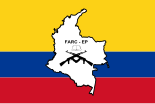Fuerzas Armadas Revolucionarias de Colombia
| Revolutionary Armed Forces of Colombia People's Army |
|
|---|---|
| Participant in the Colombian conflict | |

FARC–EP coat of arms: shield, flag, and country
|
|
| Active | 1964–2017 |
| Ideology | |
| Leaders | |
| Headquarters |
|
| Area of operations | Concentrated in southern, south-western, north-western and eastern Colombia. Incursions to Peru, Venezuela, Brazil,Panama, and Ecuador. Sporadic presence in other Latin American countries, predominantly Mexico, Paraguay, Argentina, and Bolivia. |
| Strength | 7,000–10,000 (2013) |
| Allies | |
| Opponents | |
| Flag |  |
The Revolutionary Armed Forces of Colombia—People's Army (Spanish: Fuerzas Armadas Revolucionarias de Colombia—Ejército del Pueblo, FARC–EP and FARC) was a guerrilla movement involved in the continuing Colombian armed conflict since 1964. It was known to employ a variety of military tactics in addition to more unconventional methods, including terrorism. The FARC-EP, which formed during the Cold War period as a Marxist–Leninist peasant force, allegedly promoting a political line of agrarianism and anti-imperialism. The operations of the FARC–EP were funded by kidnap and ransom; illegal mining;extortion or taxation of various forms of economic activity; and the taxation, production, and distribution of illegal drugs. The United Nations has estimated that 12% of all killings of civilians in Colombian conflict were committed by FARC and ELN guerrillas, with 80% committed by right-wing paramilitaries, and the remaining 8% committed by security forces.
The strength of the FARC–EP forces was high; in 2007, the FARC said they were an armed force of 18,000 men and women; in 2010, the Colombian military calculated that FARC forces consisted of about 13,800 members, 50 percent of whom were armed guerrilla combatants; and, in 2011, the President of Colombia, Juan Manuel Santos, said that FARC–EP forces comprised fewer than 10,000 members. In 2013 it was reported that 26,648 FARC and ELN members had decided to demobilize since 2002. According to a report from Human Rights Watch in 2006, approximately 20–30% of the recruits were minors, some of whom are forced to join the FARC. while women comprise around 40 percent of the guerilla army. The greatest concentrations of FARC forces were in the southeastern, northern and southwestern regions of Colombia's 500,000 square kilometers (190,000 sq mi) of jungle, in the plains at the base of the Andean mountain chain and in northwestern Colombia. However, the FARC and the ELN (National Liberation Army of Colombia) lost control of much of the territory, especially in urban areas, forcing them to relocate to remote areas in the jungle and the mountains.
...
Wikipedia
